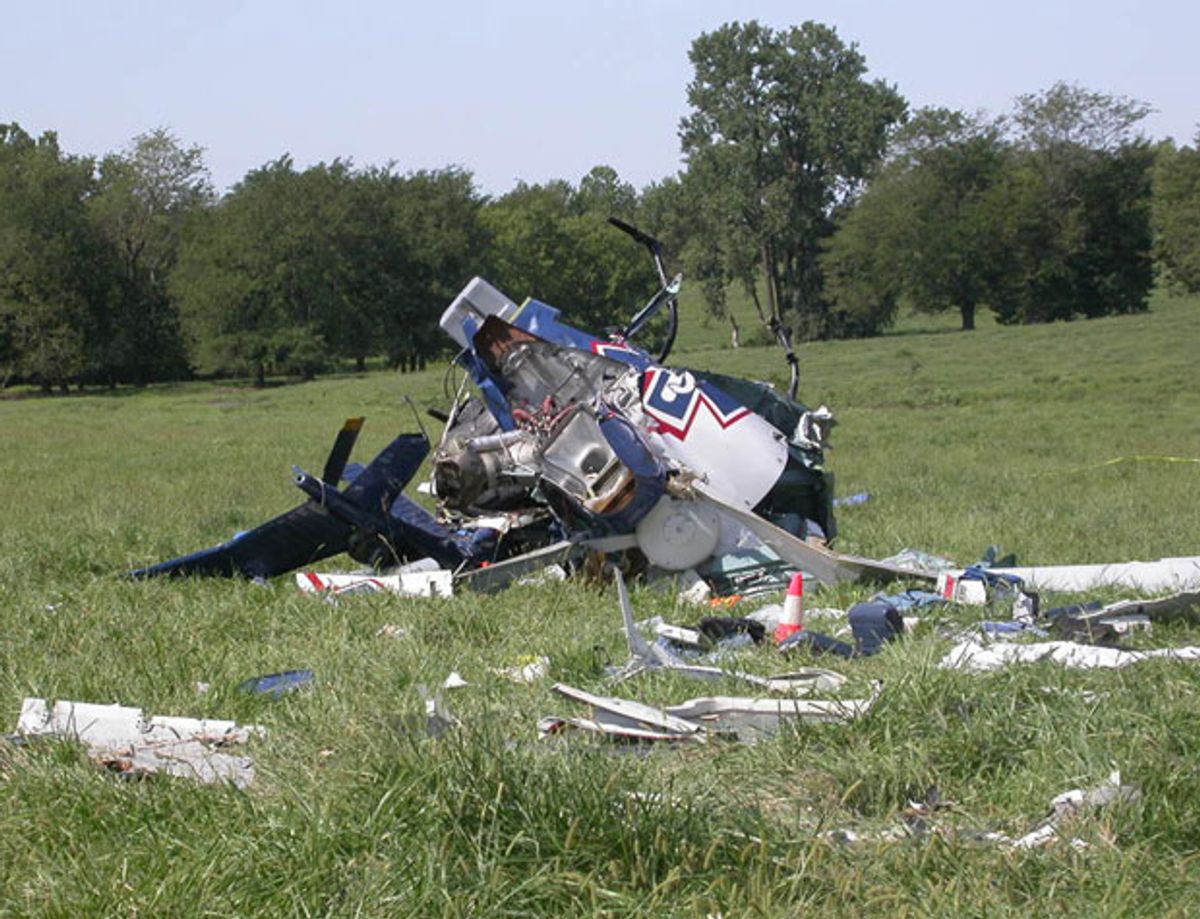Yesterday, the U.S. National Transportation Safety Board (NTSB) reviewed the findings of its investigation into the crash of a Eurocopter AS350 B2 helicopter operated by Air Methods Corporation (and doing business under the name LifeNet). On Friday, 26 August 2011, at 1840 CDT the helicopter, which was on an emergency medical services (EMS) mission, crashed following a loss of engine power as a result of fuel exhaustion a mile from Midwest National Air Center (KGPH), Mosby, Mo. The pilot, flight nurse, flight paramedic and patient were fatally injuried.
At yesterday’s NTSB inquiry, the board cited (pdf) as the probable causes of the accident “the pilot's failure to confirm that the helicopter had adequate fuel onboard to complete the mission before making the first departure, his improper decision to continue the mission and make a second departure after he became aware of a critically low fuel level, and his failure to successfully enter an autorotation when the engine lost power due to fuel exhaustion.”
In the preliminary NTSB accident report, the pilot was thought to have successfully entered into autorotation mode before the crash. However, the full NTSB investigation found this not to be the case, and believed that he may have been unsuccessful because of “the lack of practice representative of an actual engine failure at cruise airspeed in the pilot's autorotation training" in the model and make of helicopter being flown. The pilot, the NTSB found, had not received any of his autorotation training in a simulator which, the NTSB stated, would have made him “better prepared” to deal with an emergency situation.
Also contributing to the accident, the NTSB said, were “(1) the pilot's distracted attention due to personal texting during safety-critical ground and flight operations, (2) his degraded performance due to fatigue, [and] (3) the operator's lack of a policy requiring that an operational control center specialist be notified of abnormal fuel situations.”
According to the NTSB, “An examination of cell phone records showed that the pilot had made and received multiple personal calls and text messages throughout the afternoon while the helicopter was being inspected and prepared for flight, during the flight to the first hospital, while he was on the helipad at the hospital making mission-critical decisions about continuing or delaying the flight due to the [low] fuel situation, and during the accident flight.” The pilot violated company policy by texting while airborne, the NTSB noted.
The NTSB further stated that while there was no evidence that the pilot was using his cellphone when the helicopter flamed out from a lack of fuel, the NTSB believed that the “texting and calls, including those that occurred before and between flights, were a source of distraction that likely contributed to errors and poor decision-making.”
A Bloomberg News story says that this was the first time that texting while flying was listed by the NTSB as a contributing factor in a commercial air crash. Previously, texting or calling while driving has been cited in crashes involving operators of commercial trucks, motorcoaches, railroad trains and metro trains.
In addition, a story last week in the LA Times reported on recently released statistics from a National Highway Traffic Safety Administration survey [pdf]. The story states that, “At any given time, about 660 000 [U.S.] drivers are texting, tweeting, talking, or otherwise preoccupied with their cellphones while speeding along the freeways or crawling through downtowns and suburban neighborhoods.” That number represents about 5 percent of all drivers on the road at any given moment. Furthermore, the Times story says, the NHTSA survey results indicate that while California and 38 other states have tried to prohibit calling and or texting while driving, these laws have not been effective in stopping the practice. This is despite the fact that most drivers surveyed strongly support them: 75 percent support bans on cell-phone use while driving, while 94 percent support a ban on texting while driving.
Interestingly, the Bloomberg News story interviewed John Lee, an industrial and systems engineering professor at the University of Wisconsin researching human adaptation to technology among other subjects. Professor Lee indicated that what apparently happened in the helicopter accident “is different from what is commonly seen in distracted driving when a motorist takes his or her eyes off the road and causes an accident. Instead, it’s similar to an office worker who gets a phone call and forgets to send an email, said Lee, who studies people’s interaction with technology. Such distractions from multitasking have been linked to medical errors, he said” (a phenomenon that's been dubbed "distracted doctoring").
In the wake of the accident, the NTSB made nine safety recommendations to the FAA and Air Methods Corporation and reiterated three previously issued recommendations to the FAA, which can be found in its findings synopsis (pdf). Chief among them is prohibiting "flight crewmembers...from using a portable electronic device for nonoperational use...while the aircraft is being operated."
Who would have thought even just five years ago, or especially after the Northwest Airlines incident, that such a recommendation would really be necessary?
Photo: NTSB
Robert N. Charette is a Contributing Editor to IEEE Spectrum and an acknowledged international authority on information technology and systems risk management. A self-described “risk ecologist,” he is interested in the intersections of business, political, technological, and societal risks. Charette is an award-winning author of multiple books and numerous articles on the subjects of risk management, project and program management, innovation, and entrepreneurship. A Life Senior Member of the IEEE, Charette was a recipient of the IEEE Computer Society’s Golden Core Award in 2008.



